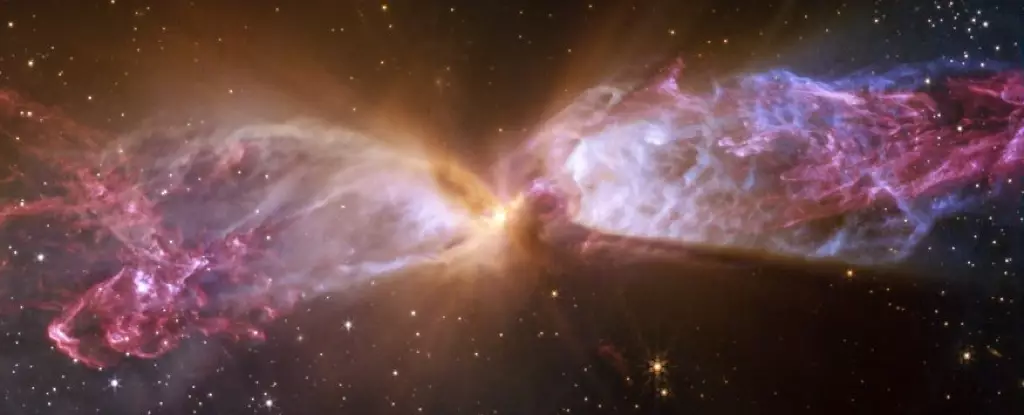When we gaze into the vastness of space, we are often mesmerized by the beauty of the stars. However, the most captivating moments in this cosmic narrative take place well before these stars fully mature. Young stars, much like exuberant children, exhibit a wild energy that manifests in diverse and chaotic forms. A striking image captured by the James Webb Space Telescope (JWST) reveals this very phenomenon in the Lynds 483 region, located about 650 light-years from Earth. Here, nascent stars unleash powerful jets of energy that sculpt their environments into fascinating hourglass shapes filled with intricate clumps and mesmerizing swirls of gas and dust.
The process of star formation is not merely a passive accumulation of matter; rather, it’s a dynamic interplay of forces. Young stars grow larger as they methodically consume the gas and dust surrounding them, transforming this material into immense celestial bodies—some of which can reach up to 200 solar masses. Yet, rather than hoarding all that material, these volatile protostars paradoxically expel some of it back into space through vigorous jets. It is this delicate balance of accretion and ejection that gives rise to the stunning visual displays observed in regions like L483.
The Celestial Laboratory of Lynds 483
Lynds 483 functions as a cosmic workshop where new stars are born amidst dense clouds of gas and dust. Nestled within this celestial nursery are two inconspicuous protostars, their brilliance obscured by a thick veil of material. Although they may appear tiny, their transformative presence is felt throughout the region, as they mold and influence the atmosphere around them. The state-of-the-art capabilities of the JWST, the most powerful space telescope ever created, enable it to delve deeper into the infrared spectrum than its predecessors. This advanced technology allows astronomers to unveil the intricacies of star formation processes in regions like L483 that are often shrouded in visible light barriers.
As these young stars draw in their primordial surroundings, they form swirling accretion disks. Not all of the accumulated material forms the stars themselves; some of it is channeled toward the poles by potent magnetic fields. This results in the ejection of powerful protostellar jets that can travel at staggering speeds of several hundred kilometers per second. What’s fascinating is that these jets are not emitted in a continuous stream; rather, they come in bursts. This intermittent nature has created intricate knots and filaments that are visually stunning and rich in the chemical precursors of life.
The Chemical Ballet of Creation
Amidst the beauty of turbulence, a hidden chemical orchestra conducts the symphony of life. The interactions within these jets lead to the formation of complex organic molecules, such as methanol and carbon dioxide. A pivotal study from 2019 highlights that these chemical reactions predominantly occur in the hot corino, the intensely heated area encircling the young stars. It is in this delicate balance, where the outward centrifugal force counteracts the inward pull of gravity, that the fascinating dynamics of star formation truly shine.
The dual protostars at the core of Lynds 483 are enveloped in a band of thick dust, casting shadows that conceal them from direct observation. However, the brilliance of the JWST unveils the vibrant surrounding environment, with stark contrasts of orange and pink light illuminating shock fronts where jets collide with denser materials in the interstellar medium. The intricate details revealed by the telescope have offered a fresh perspective on this luminosity, exposing tangled patterns of filaments that hint at dynamics yet to be fully understood.
A Journey of Discovery Amidst Unanswered Questions
While the JWST has made significant strides in enhancing our understanding of regions like L483, numerous questions remain. Observations imply a partially symmetrical yet complexly asymmetrical structure within the hourglass shape. Astronomers are excited to unite their findings and analyze how much material has been expelled by the protostars, as well as what chemicals are produced during this chaotic formation process.
Importantly, these protostars represent only the nascent phase of star evolution. It may take millions of years for them to reach the main sequence of stellar life—where they classify as stars much like our Sun. In that distant future, the jets that currently characterize them will cease, and the cloud of gas and dust will eventually be swept away. Yet, while the birth of new stars beckons, the remnants will linger—setting the stage for planets, potentially harboring life, to emerge in their newly formed circumstellar disks.
The mysteries of star formation are unfurling before our eyes, yet they also remind us of how much we still have to learn. The JWST stands as a testament to human innovation, enabling us to probe the cosmos further than ever before. Reflecting on the possibilities of future telescopes, we can’t help but wonder what new revelations await us in the eons to come.

